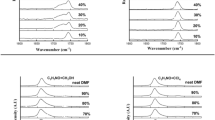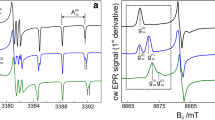Abstract
Carbon-13 magnetic resonance shifts of solvent carbon atoms were measured as a function of solute concentration for a series of alkali metal salts inN-methyl-2-pyrrolidone and 3-methyl-2-oxazolidone, which are 5-membered dipolar-aprotic heterocyclic solvents of dielectric constants 32.0 and 77.5, respectively. Chemical shifts were linear functions of solute molarities in the concentration range of 0.19–0.75M. Cation-solvent interaction decreased in tenacity as Li+>Na+>K+. Shifts were anion dependent for both solvents, and the magnitude of solvent structure shielding, by solute anions, decreased as tetraphenylborate > thiocyanate > perchlorate. The carbonyl shifts ofN-methyl-2-pyrrolidone and 3-methyl-2-oxazolidone were compared to other heterocyclic solvents.
Similar content being viewed by others
References
W. W. Paudler,Nuclear Magnetic Resonance (Allyn and Bacon, Boston 1971).
J. R. Wasson and D. R. Lorenz,Anal. Chem. 48, 246R (1976).
A. I. Popov,Solute-Solvent Interactions, Vol. 2, J. F. Coetzee and C. D. Ritchie, eds. (Marcel Dekker, 1976), Chap. 13,
A. K. Covington, T. H. Lilley, K. E. Newman, and G. A. Porthouse,J. Chem. Soc. Faraday Trans. 1 69, 963 (1973).
J. F. Hinton and E. S. Amis,Chem. Rev. 71, (6), 627 (1971).
T. Drakenberg and B. Lindman,J. Colloid Interface Sci. 44, 184 (1973).
T. L. Buxton and J. A. Caruso,J. Am. Chem. Soc. 96, 6033 (1974).
J. Rosenfarb and J. A. Caruso,Can. J. Chem. 54, 1660 (1976).
J. Rosenfarb and R. J. Baker,J. Phys. Chem. 82, 329 (1978).
P. G. Sears, W. H. Fortune and F. Blumenshine,J. Chem. Eng. Data 11, 406 (1966).
H. L. Huffman, Jr. and P. G. Sears,J. Solution Chem. 1, 187 (1972).
B. P. Fabricand and S. Goldberg,J. Chem. Phys. 34, 1624 (1961).
G. G. Levy and G. L. Nelson,Carbon-13 Nuclear Magnetic Resonance for Organic Chemists (Wiley-Interscience, 1972), pp. 112, 123–126.
H.-O. Kalinowski and H. Kessler,Org. Magn. Res. 6, 305 (1974).
M. D. Dyke, P. G. Sears, and A. I. Popov,J. Phys. Chem. 71, 4140 (1967).
B. J. Barker, H. L. Huffman, Jr. and P. G. Sears,J. Phys. Chem. 78, 2689 (1974).
Author information
Authors and Affiliations
Rights and permissions
About this article
Cite this article
Rosenfarb, J., Baugh, T.D. Carbon-13 magnetic resonance as a probe for solute-solvent interaction in dipolar heterocyclic media. J Solution Chem 7, 457–462 (1978). https://doi.org/10.1007/BF00646116
Received:
Revised:
Issue Date:
DOI: https://doi.org/10.1007/BF00646116




